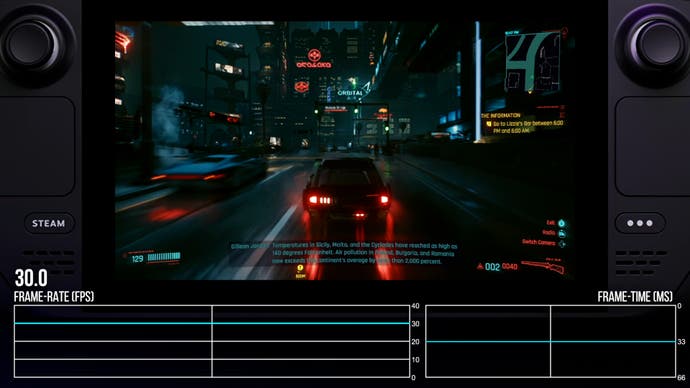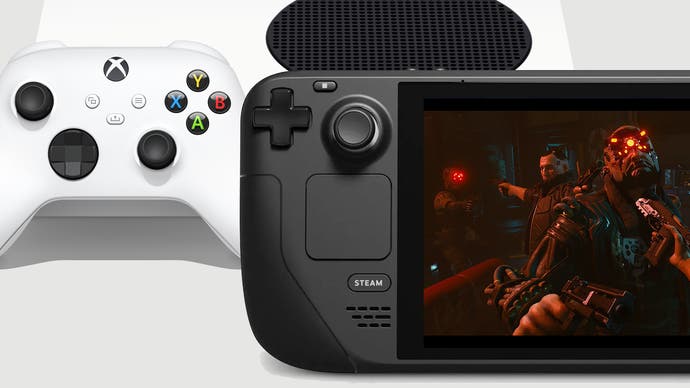Steam Deck vs Xbox Series S - how future-proof is the Valve handheld?
Testing the Deck against the baseline for next-gen games development.
Valve's Steam Deck is a seriously impressive piece of it, thanks in no small part to the power-efficient, highly capable AMD Van Gogh APU that runs the show. As we've already seen, this portable PC can match the PlayStation 4 experience at lower resolutions, while its support for ray tracing in combination with its built-in SSD stands it in good stead for future games. However, with demanding software on the horizon and last-gen systems finally starting to fall by the wayside, Microsoft's Xbox Series S is establishing itself as the baseline for modern gaming. So here's the question: can we push the Steam Deck to produce a viable portable alternative to the Series S experience - even on the most demanding games?
Looking at the specs, the two systems don't look quite as far apart as you may think. Both machines are based around the same AMD technologies - Zen 2 CPUs paired with RDNA 2 GPUs. The Steam Deck is substantially pared-back relative to its stronger console cousin, but critically it is targeting a much lower output resolution. The Series S is typically aiming for pixel counts in the 1080p to 1440p range, while the Steam Deck is limited to just 1280x800 on its internal display, or 720p with 40-pixel black bars top and bottom.
So, the fact that the Steam Deck is theoretically a little less than half as powerful in GPU compute and RAM bandwidth isn't a huge issue here. A seven-inch screen with essentially a 720p resolution is a forgiving canvas for game content relative to a large-format 4K television and in many cases, cutting resolution alone may be enough to give us the slack we need to equal the junior Xbox. One levelling factor to consider, however, concerns power consumption. Steam Deck's APU has a 15W power limit, with full system power hitting a maximum of around 26W. Meanwhile, it's impossible to gauge the Series S SoC's power draw, but the entire system maxes out at around 82W of juice measured at the wall with a watt meter. There is, however, another factor in the Deck's favour - it actually has more memory than the Series S.
| Steam Deck | Xbox Series S | |
|---|---|---|
| Graphics Technology | 1.0-1.6TF AMD RDNA 2 (8 CUs at 1.0-1.6GHz) | 4TF AMD RDNA 2 (20 CUs at 1.55GHz) |
| Central Processor | AMD Zen 2 (4 cores at 2.4-3.5GHz) | AMD Zen 2 (8 cores at 3.4GHz SMT or 3.6GHz no SMT) |
| Memory/Bandwidth | 16GB LPDDR5 at 88 GB/s | 8GB GDDR6 at 224GB/s, 2GB GDDR6 at 56GB/s |
| Internal Storage | 512GB NVMe SSD | 256GB/512GB NVMe SSD |
We can't compare every single game that runs on both Deck and Series S - the list is just too long - but by targeting key titles we can get some idea of the handheld's capabilities in the here and now, along with some idea of future prospects. In assessing each title, we're aware that some compromises will be necessary. For Series S games that target its usual 1080p-1440p profile, we'll be aiming for the Deck's native screen resolution instead - or an intelligently upscaled version of that. Detail cuts may also be necessary, but remember that these are often significantly less noticeable on a handheld screen. Another important factor is the Deck's recently acquired ability to run its display at 40-60Hz refresh rates - as we shall discover in our testing.
We kicked off testing with Cyberpunk 2077, infamous for thrashing the last-gen consoles with heavy CPU and storage loads - a situation much improved on current-gen consoles where even the Series S acquits itself well, turning out a stable and attractive presentation. On Steam Deck there are two potential paths to take here. The first path is to push settings more in line with the Series S, which seems close to the PC's high preset. Helpfully, Cyberpunk includes a bespoke Steam Deck preset - a mix of medium and high settings - which do seem like a reasonably close match for the S. Bumping the ambient occlusion setting to medium fills in the only glaring settings deficit. The price we pay for similar settings is resolution, where FSR 1.0 upscaling at its quality preset (internally rendering at 854x480) is required to consistently maintain 30fps.
Even on the Steam Deck's small screen, Cyberpunk 2077 lacks lacking clarity in this scenario, especially on distant objects. FSR does an OK job of preserving edges, although in-surface detail and fine geometry don't hold up to any sort of scrutiny. The second path is to take those Steam Deck optimised settings and make some strategic settings compromises to achieve better image quality. Dialing down volumetrics, shadows, and a few other settings allows us to bump resolution all the way to a full 720p. Cyberpunk looks so much cleaner as a result and the primary concession seems to be more obvious shadow draw-in, which isn't terribly noticeable during typical play. Both approaches yield a very consistent 30fps when paired with SteamOS's frame-rate limiter. Open-world driving can provoke a late frame or two at times but generally we are locked to 30, even during intense moments. These are extremely impressive results. Cyberpunk on a handheld, at good settings and with solid frame-rates - this is really excellent stuff.

Remedy's Control? It's another Steam Deck winner. Series S operates at 900p resolution, reconstructed up to 1080p with a mix of settings that mostly correspond to the low preset on PC. The trade-off for those settings concessions is a relatively smooth 60fps update - and remarkably we can get very close on Steam Deck. To match the Series S, we're pegging the Deck to the low preset, with textures set to high. 60fps is the target here, and 720p60 is actually possible most of the time. Smaller corridors and combat sections hit 60fps at 720p mostly but there are frequent drops. It's not a horrible experience but definitely too unstable for my taste, often hanging well below 60fps for extended periods. 720p30 on medium with the Deck's internal 30fps cap works well enough, but playing at 60fps is the right move, however - and critically we can achieve broadly Series-S level settings here.
Grid Legends is a polished, fluid and graphically accomplished arcade racer that delivers a great 60fps experience on Series S at a dynamic 1440p. Microsoft's console seems pegged to the high PC settings preset in most areas, with cubemap-based reflections and shadow map quality seemingly a match for the PC preset here. Settings tweaks to shadows, crowd density, and volumetrics are required, though you'd be hard-pressed to notice the differences on the Steam Deck's screen. The end result is a full 720p60 on Deck in typical play - though there can be some drops, particularly with vehicle collisions and heavy effects work. The solution? Drop the screen refresh to 50Hz and consistency issues are resolved, without only a small hit to fluidity versus the Series S experience.
It's not all roses for Steam Deck, however, and some titles struggle. For example, Dirt 5 uses a dynamic resolution on Series S that typically hovers around 1080p, targeting 60fps with similar settings to the PC's medium preset. It's a great-looking off-road adventure but unfortunately it doesn't scale especially well to the Steam Deck, where dropping everything to low and reducing resolution to 50 percent (aka 360p!) is required to lock to 60fps. A more conservative route is to simply lower our performance expectations and accept a cut to 30fps. By enabling the Steam Deck's built-in 30fps cap we can push features much further and achieve 720p rendering with a mix of medium and high settings. Performance is a locked 30fps during gameplay at least, with no deviance whatsoever that I could detect.
So why isn't the Steam Deck performing better here? Dirt 5's PC port is fairly unforgiving, with heavy CPU and GPU demands. Running the game through Proton, we essentially inherit the performance characteristics of the underlying PC code, so we have to make some hard choices if the port happens to be more demanding. The title still looks and runs great, but we're not particularly close to the Series S experience.

Guardians of the Galaxy rounds out our comparisons and it's a bit of a worst-case scenario for the Deck. The settings menu provides our first hint that things might not go so well: there are only a few settings with any impact on performance and in practice the game performs very similarly no matter what we select. The limited settings menu is especially odd considering that Series S appears to use some lower-than-low settings, such as grass/foliage density. If cutting back foliage is a sensible compromise for the Series S, why isn't the same option exposed in the PC settings?
The only tool we have to address the performance faults is to engage FSR 1.0, which is built-in. Unfortunately, image quality takes a big hit and the game has an upscaled, artificially-enhanced look that isn't especially pleasing - and even that's not enough to sustain a stable 30fps. Long views, combat and the use of overlay effects can cause performance dips down to the mid-20s at worst. It's definitely playable, but far from ideal. Meanwhile, flickering issues remind us that Valve's Proton layer can't always translate DirectX without issues. Most compatibility issues on the Deck are interface-related in my experience - like a game that requires mouse or touchscreen input to navigate a launcher. However, graphics issues aren't uncommon either, even if they aren't show-stopping complications.

The combination of an inflexible PC version combined with Proton flakiness produces a title that really doesn't hold up well on the Deck. The Series S doesn't acquit itself well here either, generally running at 1080p30 with a mix of settings that is impossible to replicate using the available options on PC. However, the bottom line is that image quality and performance on the Deck are just too compromised to produce a satisfying outcome.
So, can Valve's Steam Deck be a match for the Series S? In current software, the results are surprisingly close in many scenarios. The first three titles we looked at largely live up to Series S standards - but intelligent compromises can be made to deliver excellent handheld experiences. However, the system falls behind in challenging fare and is beholden to the PC port being of a decent quality in the first place. Overall, though - it's a strong showing on a range of demanding games.
Also, Valve deserves a lot of credit as SteamOS offers a ton of features to extract the most from the limited hardware. Real-time performance profiling, proper frame-rate caps, user-selectable refresh rates, a litany of upscaling options - these tools allow us to easily analyse performance issues and squeeze as much out of the power-constrained APU as we can. The software environment is easy to use while giving enthusiasts plenty of levers to tune performance just right.

Looking forward, however, there are some potential trouble spots. I suspect the CPU may prove the primary issue, with only half the multi-core performance of the new consoles even at its maximum clock-speeds. Cross-gen titles should be no problem, as the Zen 2 cluster here comfortably outperforms the eight-core Jaguars these games were designed around. Upcoming software may not be so kind however, particularly games designed around the CPU-saturating Unreal Engine where the four CPU cores with middling clocks are unlikely to cut it. Ray tracing support is also a concern owing to the lack of horsepower and the APU's power limit and although we've had some success running Metro Exodus Enhanced Edition on the Deck under Windows, the jury's still out. A more basic problem is the fact that ray-tracing is not currently supported in the handheld's default Proton build but this will hopefully change as the AMD Linux drivers continue to mature.
Ultimately, I suspect that without specific optimisation work or dramatically scaled-back settings, the Steam Deck may struggle as the generation progresses. A hypothetical 30fps game with heavy ray-tracing and burdensome CPU loads may be too challenging to run well on the Steam Deck - the required scalability may not be there to make it playable. However, the picture changes dramatically when Steam Deck is stacked up against Series S in running legacy titles.
Xbox Series S has an extensive backwards compatibility library, including a wide array of titles also available on Xbox 360. Some of these games may have received enhancements to frame-rate or resolution courtesy of the Xbox compatibility team, but many games are still locked to Xbox 360 settings. Deus Ex: Human Revolution is a good example. On Series S, we're getting a 720p30 rendition of Eidos Montreal's first-person RPG. There are some key advances here - most notably, frame-rate is locked, unlike the 360 original. However, the performance targets are all identical to the original code.

With Human Revolution, the Steam Deck is more than capable of turning out a locked 720p60 on the default settings, with plenty of performance overhead to spare. The experience is much more responsive as a result, despite the fact that the Series S offers much higher performance on paper. Without the configurability of a PC, most console backwards compatibility efforts simply replicate the original software and inherit many of its fundamental flaws.
On the other hand, some titles do see a performance uplift on Series S. Sonic & All-Stars Racing Transformed, a 2012 kart racing title, received an update late last year to give the game an 'FPS Boost' from 30fps to 60fps when running on Xbox Series consoles. Unfortunately, the game is still bound to the 1152x544 resolution of the Xbox 360 code - a mere 68 percent of native 720p. Steam Deck has no issues whatsoever hitting 720p60 here using the default settings and again, the performance metrics suggest we could push the system further. These older titles run really nicely on the Deck, hitting high frame-rates with lots of processing time to spare. This is where Valve's system feels most comfortable, and where its advantages over rigid console platforms are most pronounced.
Let's close things out. In contemporary games, the Steam Deck can achieve a performance profile remarkably similar to the Series S in a range of games - though suitable tweaks are required. The Deck needs to be pushed right to the edge to get there - with poor battery life as a result - but the results are seriously impressive. Looking ahead, the outlook is a bit more cloudy, as certain hardware shortcomings are bound to become more obvious over time - the CPU in particular. But when the Steam Deck is firing on all cylinders, it can absolutely achieve the portable Series S dream and the results are often brilliant.


